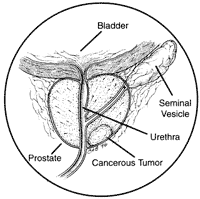|
 
Prostate cancer is the most common type of cancer
found in American men. The number of new cases diagnosed
each year has doubled over the last 10 years, largely
because of improved tests that help detect prostate
cancer. Although prostate cancer can occur in men
of all ages, it occurs more frequently in men over
50 and is the most common in men over 65. African-American
men and men with close family members who had prostate
cancer are more likely to develop this cancer than
other men. The cause of prostate cancer is unknown.
 What
is the prostate and where is it? What
is the prostate and where is it?
The prostate is a gland located just below the bladder
and in front of the rectum. It wraps around a tube
called the urethra, which carries urine and semen,
the white fluid that contains sperm.
The prostate gland starts
out about the size of an almond and remains that size
until boys reach puberty, when it doubles in size.
When a man is 45 years old, the prostate often starts
growing again. In some men, it will continue to grow
for the rest of their lives. This growth is made up
of benign tissue and is known medically as benign
prostatic hyperplasia, or BPH. BPH is not cancer
nor does it lead to cancer, but it can interfere with
the normal flow of urine and cause uncomfortable symptoms.
BPH causes symptoms because it occurs in the center
of the prostate gland where the urethra carries the
urine.
What is prostate cancer?
Prostate cancer begins inside the prostate and may
grow to involve the entire gland and then spread to
other parts of the body. Some prostate cancers grow
slowly, while other prostate cancers can be very aggressive,
spreading quickly to other parts of the body, especially
the lymph nodes and the bones. This is called metastasis.
How is prostate cancer diagnosed?
A biopsy is the only way
to know for sure if you have prostate cancer.
Your doctor
may have been concerned about results of your prostate
specific antigen (PSA) blood test or felt something
that was not normal while doing a digital rectal
exam
(DRE) and ordered a biopsy.
A biopsy is a procedure,
normally done in the doctor's office, where several
small
pieces of prostate tissue are removed through a thin
needle and examined for cancer under a microscope.
Biopsies are often done during a procedure called
a transrectal ultrasound (TRUS).

Notice: Information on this web site is provided for informational
purposes only and is not a substitute for professional medical advice. You
should not use the information on this web site for diagnosing or treating
a medical or health condition. If you have or suspect you have a medical
problem, promptly contact your professional healthcare provider.
|
|



